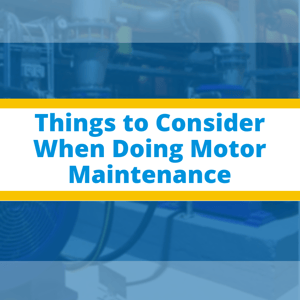 Maintenance of electrical motors and related equipment is one of the most mission-critical tasks for an industrial plant, and for good reason. Motors are the primary source of productivity and form the backbone of all operations within a plant, driving virtually every major equipment from pumps to conveyors. If an interruption arises then it can greatly affect the productivity and with that the economic efficiency of the plant.
Maintenance of electrical motors and related equipment is one of the most mission-critical tasks for an industrial plant, and for good reason. Motors are the primary source of productivity and form the backbone of all operations within a plant, driving virtually every major equipment from pumps to conveyors. If an interruption arises then it can greatly affect the productivity and with that the economic efficiency of the plant.
The following are six key techniques through which effective motor maintenance may be carried out:
Replacement Analysis
For this technique to be successful, it is vital that an updated changelog be maintained regarding the repair operations carried out on the motor. When a motor fails, going through the changelog can help determine the cause of failure. By going through each replaced component, its effect on the suitability of the motor can be determined and the problem can be traced.
Cost of Repair vs. Replacement
Motor repair often seems to be a less time consuming as well as cheaper path compared to complete replacement. However, repair isn’t always the best choice and should only be carried out if a cost-benefit analysis puts it up as a favorable choice. For instance, if the rotor, body or stator core undergoes severe damage, then the number of repairs may have an increased cost compared to a replacement, which will also add to the warranty life of the motor. This is particularly true for older motors with expired warranty and support.
Determine and Address Root Cause
When failure does occur, it is worthwhile to carry out a root-cause analysis as doing so allows mitigation of the same problem in the future. It must be noted that even though the cost of motor repair/replacement is high, the losses in terms of lost productivity are much higher. Therefore, it would be wise decision to get to the root of the problem, e.g. “presence of harmonics that leads to burned down insulation and worn-down stator winding”, and address it by, e.g. “installation of an LCL filter”.
Predictive Maintenance Techniques
Early warning systems can help prevent motor failures in the midst of operations, and thus save companies from losing productivity. Through Preventive Maintenance and Predictive Maintenance technologies, sensors are used to monitor the state of motors, data from which is then either fed to a learning algorithm or to data scientists, helping them determine the onset of the next failure. These technologies have gained significant traction thanks to the increased industry interest towards Internet of Things and Industry 4.0.
ANSI/EASA Standards
The ANSI/EASA AR100-2015 Standard recommends best practices for the repair of rotating electrical apparatus, describing comprehensive guidelines regarding the testing, analysis and housekeeping of different types of motors. Even though the guidelines aren’t intended to be a replacement for manufacturer specifications, they can be used as supplementations.
To understand the importance of the standard, it must be known that several service centers use it as a pillar of their operation as it has been shown to bring consistency in the repairs while also increasing the reliability of an after-service motor.
EASA Accreditation
EASA has developed an international accreditation program through which it evaluates service centers to ensure that best practices are being used for the maintenance of motor efficiency and reliability while repairs are taking place. Currently, the program is limited in scope, including only three-phase squirrel cage induction motors, but due to its success, is bound to include more motor types in the future.
Interested in learning more? Visit our website www.premierautomation.com, or talk to one of our specialists today.



